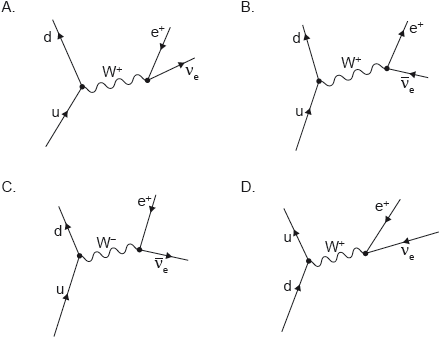| Date | May 2019 | Marks available | 1 | Reference code | 19M.2.SL.TZ1.2 |
| Level | Standard level | Paper | Paper 2 | Time zone | 1 |
| Command term | Outline | Question number | 2 | Adapted from | N/A |
Question
Silicon-30 can be formed from phosphorus-30 by a process of beta-plus decay.
Write down the nuclear equation that represents this reaction.
Sketch the Feynman diagram that represents this reaction. The diagram has been started for you.
Energy is transferred to a hadron in an attempt to separate its quarks. Describe the implications of quark confinement for this situation.
The Standard Model was accepted by many scientists before the observation of the Higgs boson was made.
Outline why it is important to continue research into a topic once a scientific model has been accepted by the scientific community.
Markscheme
✔
✔
Subscript on neutrino not necessary to award MP2.
Allow the use of β for e.
Do not allow an anti-neutrino for MP2.
correct change of either u to d ✔
W+ shown ✔
correct arrow directions for positron and electron neutrino ✔
Allow ECF from MP2 in ai for MP3.
quarks cannot be directly observed as free particles/must remain bound to other quarks/quarks cannot be isolated ✔
because energy given to nucleon creates other particles rather than freeing quarks/OWTTE ✔
models need testing/new information may change models/new technology may bring new information/Models can be revised/OWTTE ✔
Look for responses that suggest changes/improvements to models.
Don’t accept answers specifically about the Standard Model.
Don’t accept answers about simply proving the model correct.
Examiners report
Few candidates were awarded full marks for a variety of reasons for the Feynman diagram they drew, and many left this question blank. It should be noted that on the exam the time axis can either be vertical or horizontal, so candidates should be familiar with both methods of drawing Feynman diagrams. Candidates should be able to draw Feynman diagrams from scratch either way. The examiners were looking for the basics of drawing a diagram (proper change in quark structure, proper exchange particle, and proper arrow directions for the positron and neutrino).
Few candidates recognized that quarks cannot exist in isolation, and fewer still could discuss the effect of adding energy to attempt to separate quarks. Some recognized that the added energy would ultimately be converted into mass, but few clearly specified that this would form new particles (such as mesons) rather than just new quarks.
This was a “nature of science” question. The examiners were looking for the idea that models can be improved on and revised by new data rather than just proven right or wrong.


